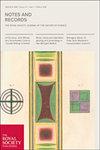温度计屏幕和19世纪气象学的一致性地理
IF 0.6
3区 哲学
Q3 HISTORY & PHILOSOPHY OF SCIENCE
Notes and Records-The Royal Society Journal of the History of Science
Pub Date : 2018-10-24
DOI:10.1098/rsnr.2018.0037
引用次数: 6
摘要
到19世纪60年代,许多温度计架、屏幕和盒子被用于公共观测站和私人场所。这些简陋的科学基础设施的最终目的是保护温度计免受降水和辐射的影响。为了回应对设计质量和结果可比性的关注,1868年在汉普郡的斯特拉斯菲尔德·图吉斯对各种仪器进行了试验,随后的讨论由英国气象学会组织(从1883年起,皇家气象学会)。为了保证曝光的均匀性,该协会建议采用史蒂文森屏幕,这是一种由托马斯·史蒂文森于1866年设计的双百叶盒子。它被推广为协会在英格兰的二级气象站和气象站网络的重要组成部分。尽管气象学会的目标是通过使用统一的图案屏幕来克服地理特征,但他们选择的设计最终体现了一种特殊的地理特征:郊区家庭花园的美学和道德准则。本文章由计算机程序翻译,如有差异,请以英文原文为准。
Thermometer screens and the geographies of uniformity in nineteenth-century meteorology
By the 1860s a number of thermometer stands, screens and boxes were being used at public observatories and in private settings. The ultimate object of these humble pieces of scientific infrastructure was to protect the thermometers from precipitation and radiation. In response to concerns over the quality of designs and the comparability of results a trial of the various apparatuses was staged at Strathfield Turgiss, Hampshire, in 1868, and subsequent discussions were organized by Britain's Meteorological Society (from 1883 the Royal Meteorological Society). In an attempt to guarantee uniformity of exposure, the Society recommended the adoption of the Stevenson screen, a double-louvred box designed by Thomas Stevenson in 1866. It was promoted as an essential part of the Society's network of second-order and climatological stations across England. Despite the Meteorological Society's aim of overcoming the idiosyncrasies of geography through recourse to a uniform pattern screen, their chosen design ended up embodying a particular geography: the aesthetic and moral codes of the suburban domestic garden.
求助全文
通过发布文献求助,成功后即可免费获取论文全文。
去求助
来源期刊
CiteScore
1.50
自引率
0.00%
发文量
45
审稿时长
>12 weeks
期刊介绍:
Notes and Records is an international journal which publishes original research in the history of science, technology and medicine.
In addition to publishing peer-reviewed research articles in all areas of the history of science, technology and medicine, Notes and Records welcomes other forms of contribution including: research notes elucidating recent archival discoveries (in the collections of the Royal Society and elsewhere); news of research projects and online and other resources of interest to historians; essay reviews, on material relating primarily to the history of the Royal Society; and recollections or autobiographical accounts written by Fellows and others recording important moments in science from the recent past.

 求助内容:
求助内容: 应助结果提醒方式:
应助结果提醒方式:


